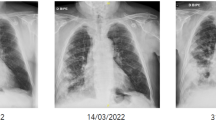Abstract
A 13-year-old Moroccan boy in The Netherlands developed fever and a lesion resembling ecthyma gangrenosum on the abdomen during cytostatic drug treatment for a lymphoblastic B-cell lymphoma.Scytalidium dimidiatum was cultured from blood and the abdominal skin lesion. The patient was successfully treated with amphotericin B. The fungusScytalidium dimidiatum is a fairly common plant pathogen in tropical and subtropical countries and is known to cause dermatomycoses in humans in these areas. This case demonstrates that it is necessary to be aware that immigrants from these areas can import their own fungal flora, some members of which may cause life-threatening disease in the case of patients with immune suppression.
Similar content being viewed by others
References
Hawkins C, Amstrong D: Fungal infections in the immunocompromised host. Clinics in Haematology 1984, 13: 599–630.
Gold JWM: Opportunistic fungal infections in patients with neoplastic disease. American Journal of Medicine 1984, 76: 458–463.
Whimbey E, Gold JWM, Polsky B, Dryansky J, Hawkins C, Blevins A, Brannon P, Kiehn TE, Amstrong D: Bacteremia and fungemia in patients with the acquired immune deficiency syndrome. Annals of Internal Medicine 1986, 104: 511–514.
Bodey GP: The emergence of fungi as major hospital infections. Journal of Hospital Infection 1988, 11, Supplement A: 411–426.
Horn R, Wong B, Kiehn TE, Amstrong D: Fungemia in a cancer hospital: changing frequencies, earlier onset, and results of therapy. Reviews of Infectious Diseases 1985, 7: 646–655.
Anaissie E: Emerging fungal pathogens. European Journal of Clinical Microbiology and Infectious Diseases 1989, 8: 323–330.
Anaissie E, Bodey GP, Kantarjian H, Ro J, Vartivarian SH, Hopfer R, Hoy J, Rolston K: New spectrum of fungal disease in patients with cancer. Reviews of Infectious Diseases 1989, 11: 369–378.
Campbell CK, Aziz K, Abdel-Aziz AHM, Hodgson C: Fungal infections of skin and nails byHendersonula toruloidea. British Journal of Dermatology 1973, 89: 45–52.
Müller-Weihreich S, Hensen G, Langermann HJ, Oberwald-Reihm HM: Kindliche B-Zell Lymfome und Leukemien. Verbesserung der Prognose durch eine für B-Neoplasien konzipierte Therapie der BFM Studiengruppe. Onkologie 1984, 7: 205–208.
Campbell CK: Studies onHendersonula toruloidea isolated from skin and nail. Sabouraudia 1971, 12: 150–156.
Nattrass RM: A new species ofHendersonula (H. toruloidea) on deciduous trees in Egypt. Transactions of the British Mycology Society 1933, 18: 189–198.
Sutton BC, Dyko BJ: Revision ofHendersonula. Mycology Research 1989, 93: 466–488.
Gentles JC, Evans EGV: Infection of the feet and nails withHendersonula toruloidea. Sabouraudia 1970, 8: 72–75.
Carruthers JA, Stein L, Black WA: Persistent skin and nail infection by an exotic fungus,Hendersonula toruloidea. Canadian Medical Association Journal 1982, 127: 608.
Ho Ping Kong B, Kapica L, Lee R: Keratin invasion byHendersonula toruloidea, a tropical pathogenic fungus resistant to therapy. International Journal of Dermatology 1984, 23: 65–66.
Hay RJ, Moore MK: Clinical features of superficial fungal infections caused byHendersonula toruloidea andScytalidium hyalinum. British Journal of Dermatology 1984, 110: 677–683.
Moore MK:Hendersonula toruloidea andScytalidium hyalinum infections in London, England. Journal of Medical Veterinary Mycology 1986, 24: 219–230.
Frankel DM, Rippon JW:Hendersonula toruloidea infection in man. Index cases in the non-endemic North American host and a review of the literature. Mycopathologia 1989, 105: 175–186.
Mariat F, Liautaud B, Liautaud M, Marill FG:Hendersonula toruloidea, agent d'une dermatite verruqueuse mycosique observée en Algérie. Sabouraudia 1978, 16: 133–140.
Drouhet E, Drouhet B: Laboratory and clinical assessment of ketoconazole in deep-seated mycoses. American Journal of Medicine 1983, 74: 30–47.
Meunier F: Fungal infections in the compromised host. In: Rubin RH, Young LS (ed): Clinical approach to infection in the immunocompromised host. Plenum, New York, 1988, p. 193–220.
Fine JD, Miller JA, Harrist TJ, Haynes HA: Cutaneous lesions in disseminated candidiasis mimicking ecthyma gangrenosum. American Journal of Medicine 1981, 70: 1133–1135.
Greene SL, Su WP, Muller SA: Ecthyma gangrenosum: report of clinical, histopathologic and bacterial aspects of eight cases. Journal of American Academy of Dermatology 1984, 11: 781–787.
Huminer D, Siegman-Igra Y, Morduchowicz G, Pitlik SD: Ecthyma gangrenosum without bacteremia. Report of six cases and a review of the literature. Archives of Internal Medicine 1987, 147: 299–301.
Author information
Authors and Affiliations
Rights and permissions
About this article
Cite this article
Benne, C.A., Neeleman, C., Bruin, M. et al. Disseminating infection withScytalidium dimidiatum in a granulocytopenic child. Eur. J. Clin. Microbiol. Infect. Dis. 12, 118–121 (1993). https://doi.org/10.1007/BF01967587
Issue Date:
DOI: https://doi.org/10.1007/BF01967587




